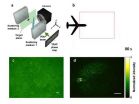(Press-News.org) Bariatric (weight loss) surgery, such as gastric bypass or gastric banding, could reduce the risk of developing type 2 diabetes by around 80% in obese people, compared with standard care, new research published in The Lancet Diabetes & Endocrinology journal suggests.
Being overweight or obese is the main modifiable risk factor for type 2 diabetes. More than 80% of adults with type 2 diabetes are overweight or obese [1]. In England, just over a quarter of adults (26%) were classified as obese in 2010 (body mass index [BMI] 30kg/m2 or over)[2]. Up to 3% of people with severe obesity (BMI 40kg/m2 or more) develop diabetes each year.
Using electronic health records from the UK Clinical Practice Research Datalink, Martin Gulliford, Professor of Public Health at King's College London, UK, and colleagues assessed the effect of contemporary surgical weight loss procedures on the development of diabetes.
They identified 2167 obese adults without diabetes who underwent one of three surgical procedures (laparoscopic adjustable banding, sleeve gastrectomy, or gastric bypass) for weight loss from 2002 onwards. These participants were compared with 2167 controls matched for age, sex, BMI, and blood glucose control (measured as HbA1c) who did not have surgery or other obesity treatments. Participants were followed up for a maximum of 7 years (median 2.8 years).
During follow-up, 38 new diagnoses of diabetes among participants who had weight loss surgery were recorded, compared with 177 in control participants. Compared with controls, diabetes incidence was reduced by about 80% in participants who had surgery, even after controlling for other important factors including smoking, high blood pressure, and high cholesterol.
According to Professor Gulliford, "Our results suggest that bariatric surgery may be a highly effective method of preventing the onset of new diabetes in men and women with severe obesity. We need to understand how weight loss surgery can be used, together with interventions to increase physical activity and promote healthy eating, as part of an overall diabetes prevention strategy." [3]
Writing in a linked Comment, Dr Jacques Himpens from Saint Pierre University Hospital in Brussels, Belgium, says, "Although the results...bring us a step closer to confirming the effect of bariatric surgery on the incidence of de-novo type 2 diabetes, many questions still remain unanswered, and more evidence is needed to convince endocrinologists about the nature of this effect."
INFORMATION:
This study was funded by the UK National Institute for Health Research.
[1] Public Health England, 2014. Adult Obesity and Type 2 Diabetes. https://www.gov.uk/government/uploads/system/uploads/attachment_data/file/338934/Adult_obesity_and_type_2_diabetes_.pdf and Centers for Disease Control and Prevention. National diabetes fact sheet: National estimates and general information on diabetes and prediabetes in the United States, 2011 http://www.cdc.gov/diabetes/pubs/factsheet11.htm
[2] http://www.hscic.gov.uk/catalogue/PUB05131/obes-phys-acti-diet-eng-2012-rep.pdf
[3] Quote direct from author and cannot be found in text of Article.
Cold Spring Harbor, NY – Scientists at Cold Spring Harbor Laboratory (CSHL) today announced a new way to dramatically increase crop yields by improving upon Mother Nature's offerings. A team led by Associate Professor Zachary Lippman, in collaboration with Israeli colleagues, has discovered a set of gene variations that can boost fruit production in the tomato plant by as much as 100%.
Plant breeders will be able to combine different gene variants among the set to create an optimal plant architecture for particular varieties and growing conditions. The set of mutations ...
A new study of the Amazon River basin shows lowland rivers that carry large volumes of sediment meander more across floodplains and create more oxbow lakes than rivers that carry less sediment.
The findings have implication for the Amazonian river system, which may be significantly altered by proposed mega-dams that would disrupt sediment supplies.
Researchers from Cardiff University's School of Earth and Ocean Sciences examined 20 reaches within the Amazon Basin from Landsat imagery spanning nearly 20 years (1985 to 2013).
They found rivers transporting larger amounts ...
CINCINNATI—An antibody abundant in mice and previously thought to offer poor assistance in fighting against infection may actually play a key role in keeping immune responses in check and preventing more serious self-inflicted forms of kidney disease, researchers say.
Led by researchers at the University of Cincinnati (UC) and Cincinnati Children's Hospital Medical Center and published online Nov. 2, 2014, in the journal Nature, the study finds that the mouse antibody IgG1, which is made in large quantities and resembles a human antibody known as IgG4, may actually ...
Two photons in free space do not interact. Light waves can pass through each other without having any influence on each other at all. For many applications in quantum technology, however, interaction between photons is crucial. It is an indispensable prerequisite for transmitting information through tap-proof quantum channels or for building optical logic gates. At the Vienna University of Technology (TU Wien), scientists have now succeeded in establishing a strong interaction between two single photons. This opens up completely new possibilities for quantum optics. The ...
As a child, it was fascinating to put a flashlight up to our palms to see the light shine through the hand. Washington University in St. Louis engineers are using a similar idea to track movement inside the body's tissues to improve imaging of cancerous tissues and to develop potential treatments.
Lihong Wang, PhD, the Gene K. Beare Distinguished Professor of Biomedical Engineering at the School of Engineering & Applied Science is applying a novel time-reversal technology that allows researchers to better focus light in tissue, such as muscles and organs.
Current ...
Nate Silver and Richard Feynman walk into a bar and bump into a biologist . . .
While this may sound like the setup to some late-night nerd sketch, researchers have taken this premise and applied it to an increasingly cumbersome problem in modern biology, namely, finding meaning in the rising oceans of genomic data.
In this specific instance, the data comprisesreams of cancer mutations that genome-wide studies are publishing at a dizzying rate. The challenge is finding new and efficient ways to parse the signal from the noise (and there is no shortage of noise).
As ...
A disappearing act was the last thing Rice University physicist Randy Hulet expected to see in his ultracold atomic experiments, but that is what he and his students produced by colliding pairs of Bose Einstein condensates (BECs) that were prepared in special states called solitons.
Hulet's team documented the strange phenomenon in a new study published online this week in the journal Nature Physics.
BECs are clumps of a few hundred thousand lithium atoms that are cooled to within one-millionth of a degree above absolute zero, a temperature so cold that the atoms march ...
Antibodies, in charge of recognizing and homing in on molecular targets, are among the most useful tools in biology and medicine. Nanobodies – antibodies' tiny cousins – can do the same tasks, for example marking molecules for research or flagging diseased cells for destruction. But, thanks to their comparative simplicity nanobodies offer the tantalizing prospect of being much easier to produce.
Unfortunately, their promise hasn't been fully realized, because scientists have lacked an efficient way of identifying the nanobodies most closely tuned to their ...
Invisible tattoos could replace the permanent dark ink tattoos used to ensure that breast cancer patients having radiotherapy are treated in exactly the same spot during each session, according to results from a pilot study to be presented at the National Cancer Research Institute (NCRI) Cancer Conference today (Sunday)*.
Research suggests that the permanent pin prick marks made on the skin of women having radiotherapy reminds them of their diagnosis for years to come, reducing body confidence and self-esteem.
It's also more difficult to spot these tattoos in dark-skinned ...
Scientists have identified more than 800 markers in the blood of cancer patients that could help lead to a single blood test for early detection of many types of cancer in future, according to research presented at the National Cancer Research Institute (NCRI) Cancer Conference in Liverpool today (Sunday).
This is the first time that cancer-specific blood markers have been comprehensively reviewed and identified for further clinical development. This study, by the UK Early Cancer Detection Consortium*, funded by Cancer Research UK, has analysed 19,000 scientific papers ...


